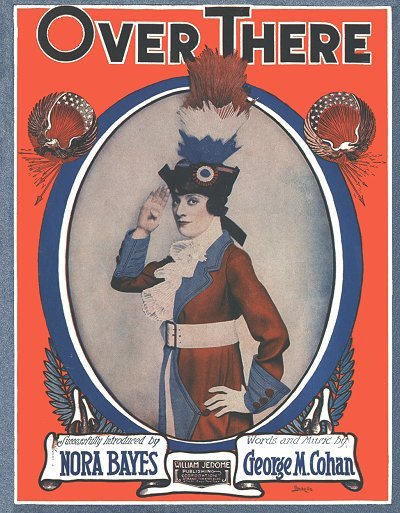
 Albert Wilfred Barbelle (February 15, 1887 to February 3, 1957) | |
 Selected Covers (Hover to View) Selected Covers (Hover to View) | |
Albert Barbelle was of French Canadian and American descent. Born in Fall River, Massachusetts to Alfred Wilfred Barbelle and Mary "Marie" Marcotte., Albert was the middle of five children in the family. There were other branches of the Barbelle family in Fall River as well, many of them being Albert's first cousins. His father died in the mid-1890s.
Albert spent much of his initial formal art study in his teens in both Paris and London, learning both traditional and commercial art.

 Once back in the U.S. in New York City in the 1910s, he attended the Art Student League and continued painting, but also contracted as an advertising and sheet music cover artist. By the mid-1910s Albert was focusing largely on the more lucrative art for hire, while still maintaining his affinity for oil painting on the side. Some off the first Barbelle covers started appearing in 1912, and the overall quantity of them, which may be second only to the Starmer brothers, increased throughout the decade. His 1917 draft record has him listed as a commercial artist and designer working for the publishing house of Waterson, Berlin & Snyder. A few months later on December 12, 1917, Albert was married to Margaretha M. Decker in Yonkers, New York.
Once back in the U.S. in New York City in the 1910s, he attended the Art Student League and continued painting, but also contracted as an advertising and sheet music cover artist. By the mid-1910s Albert was focusing largely on the more lucrative art for hire, while still maintaining his affinity for oil painting on the side. Some off the first Barbelle covers started appearing in 1912, and the overall quantity of them, which may be second only to the Starmer brothers, increased throughout the decade. His 1917 draft record has him listed as a commercial artist and designer working for the publishing house of Waterson, Berlin & Snyder. A few months later on December 12, 1917, Albert was married to Margaretha M. Decker in Yonkers, New York.


According to a notice in Variety on January 15, 1919, Albert was the in throes of a divorce with Margaretha. The 1920 census showed Barbelle as a studio artist. It inicated that he had possibly recently married his second wife Irene K Warriex, and Alfred's mother was residing with the couple. However, the nuptials were not official until July 21, some months after the enumeration. The 1930 census still had him listed as a commercial artist. But he was not just engaged in music covers, as a July 9, 1927 notice in The Billboard noted that, "When the music business falls into a slump Albert Barbelle, title page artist, keeps busy making sketches for book jackets." He was also engaged in making signs and posters for the Broadway theatrical community. During the 1920s and 1930s his scope of work expanded into scenic artwork for the stage, and even interior decoration, very likely including some of his own custom artwork for clients.
Among Albert's more notable projects in the 1930s was providing illustrations for the important release of William Grant Still's folio of arrangements, Twelve Negro Spirituals, published by W.C. Handy in 1937. Albert's marriage to Irene ended when she died on February 24, 1934. Barbelle's involvement with music increased when he married Austrian-born composer and concert pianist Paula Fuchs on April 25, 1936, in New Rochelle New York. She was also a composer, having written Dusting Stars Around the Moon with cover artwork provided by her now-husband. The 1940 enumeration showed the couple living in Manhattan, and although Paula was listed as a piano teacher, Albert listed "radio reader" as his occupation. By 1942 he and Paula were living in Richmond, Staten Island, New York, with Albert showing only that he owned his own business, possibly his art studio, which was still in Manhattan on 45th Street. The 1950 enumeration showed Albert and Paula in Richmond, with Albert continuing to list his occupation as a commercial artist.
Later in his life Albert was able to arrange some gallery shows of his more serious beautiful paintings. Barbelle's last cover, The Party's Over from the show Bells Are Ringing, appeared late in 1956, capping a cover career of some 44 years. He was actively involved as an artist in the community, largely with the Staten Island Museum in New York City, until his death in February of 1957. Albert died just two weeks shy of his 70th birthday following two months of ill health. Paula survived him until 1975, when she passed away in Miami, Florida.
Barbelle's work was wide ranging, including enhancing photographic subjects, fantasy creations and interesting silhouettes, a series of what would now be considered politically incorrect African-American themed humorous greeting cards. He even did some work illustrating the early Mickey Mouse in print in the early 1930s, having drawn the famous Disney character for Mickey's first book. But his forte was in painting beautiful women. He was very conscious of style and fashion, and was careful to keep his work contemporary as both of those elements evolved through the decades. His use of color was more subtle than that of some artists, but always tasteful, often with one particular hue deliberately highlighting a picture for effect. The volume of work turned out in some forty years was quite impressive, with the earlier large format sheets usually signed with his full name, but later works only as Barbelle.